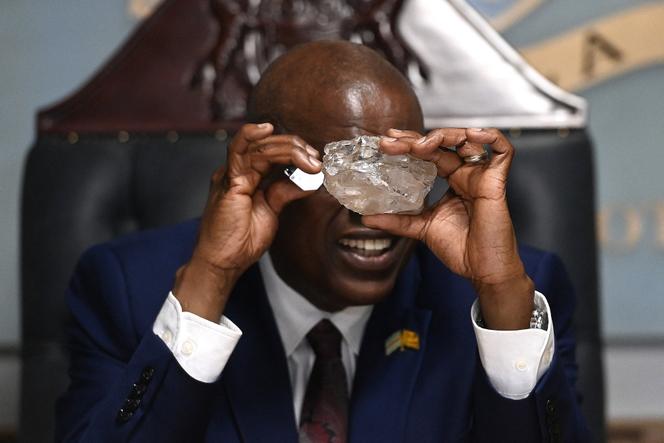


"I can see roads being built, I see hospitals and I can see kids going to school ..." No, Mokgweetsi Masisi wasn't reading the future in a crystal ball, but in the 2,492-carat diamond discovered in August at the Karowe mine in central Botswana. The head of state, who showed the gem to the press on August 22, knows only too well the profit his country of 2.7 million inhabitants will reap from the sale of this gem, estimated at over $40 million (over €36 million). According to several experts, the half-kilogram stone is the second-largest diamond ever found, and the largest in a century.
History proves the Botswanan president's point. Since independence in 1966, diamond sales have financed numerous roads, hospitals and schools in this country the size of France. Botswana is Africa's leading diamond producer and the second in the world, behind Russia. Gemstones are vital to its economy. Their sales account for around 80% of its exports, a third of its tax revenues and a quarter of its GDP, according to the International Monetary Fund (IMF).
With two months to go before the presidential election – in which he is a candidate – Masisi pulled out all the stops at the presentation of this new national jewel. In front of the television cameras assembled in his State House office, he meticulously inspected this rare, translucent object the size of a tennis ball. He put on jeweler's glasses, made a face and exclaimed "Wow!" in front of his ministers gathered for the occasion. It was a well-crafted marketing operation.
If the president became the sales representative for this precious stone for a day, it's because he's aware that the current collapse of the diamond industry is threatening the Botswanan economy. The diamond market is in freefall worldwide – prices have fallen by around 30% since 2022 – following the arrival of synthetic stones. "Laboratory diamonds have broken market prices and continue to get cheaper and cheaper," said historian Duncan Money, a specialist in the mining industry.
These new stones, the result of a technological laboratory process, are more than 10 times less expensive than genuine diamonds from traditional mining. The raw materials of the mining industry are sometimes difficult to trace, and are sometimes referred to as "blood diamonds." Today, one out of every two engagement rings sold in the US is topped with a synthetic diamond. China is at the forefront of this segment: Beijing produces over 90% of the world's cultured jewelry.
The crisis is such that the large mining company Anglo American wants to sell its 85% stake in De Beers, the world's number one diamond producer. The remaining 15% is held by Debswana, a joint venture between the company and the state of Botswana. The country in southern Africa is vital for De Beers, which produces 70% of its diamonds there. In short, "De Beers and the Botswanan government are bound by mutual dependence," said Money.
Debswana's uncut diamond sales fell by 49.2% in the first half of the year. The negative market outlook forced Gaborone to react in order to generate more revenue from its resources. In 2023, after a long power struggle, Masisi forced De Beers to renegotiate the sales agreement. Under the original agreement, dating from 2011, the company received 90% of uncut diamond production. Today, Gaborone's share is 25% and will eventually be 50%.
Although classified as an upper-middle-income country – alongside Brazil, South Africa and China – Botswana could encounter severe economic turbulence. "We expect growth to slow to 1.1% in 2024, from 2.7% in 2023, largely due to the deteriorating outlook in the diamond sector," said Emmanuel Kwapong, economist at Standard Chartered Bank. "More emphasis needs to be placed on diversification," continued the analyst, who advocates "business-friendly reforms to improve Botswana's competitiveness in non-diamond sectors."
Yet while Money pointed out that "Botswana's economic management over recent decades has been remarkable, particularly when compared to other countries with mining-dependent economies," its reserves of rare metals, copper, nickel and manganese remain "in insufficient quantities to compensate for the loss of gem-generated revenues."
To prepare for the post-diamond era, Botswana set up the Pula Fund (named after the national currency) in 1993 to invest in surplus gemstone sales. Today, it manages a portfolio of $4.1 billion in assets.
Translation of an original article published in French on lemonde.fr; the publisher may only be liable for the French version.
